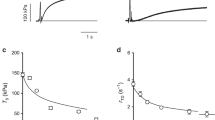Abstract
ONE of the major unsolved problems in clinical nephrolog is the way cellular electrolyte disturbances develop in uraemic patients. The studies of Bergström1 have shown abnormalities in the electrolyte content of the skeletal muscle of patients suffering from acute or chronic uraemia. Other lines of evidence suggesting toxic sequelae come from the studies of Kuroyanagi, Kurisu, Sugiyama and Saito2, Morgan and Morgan3, Giovannetti, Balestri and Cioni4, and Welt, Sachs and McManus5, using red blood cells. Welt et al. have found that the activity of the sodium–potassium–ATPase of erythrocytes obtained from uraemic subjects is reduced and the internal sodium concentration of these cells increased. This is the pattern that would be expected to accompany the direct action of toxins on the sodium transport system of erythrocytes.
This is a preview of subscription content, access via your institution
Access options
Subscribe to this journal
Receive 51 print issues and online access
$199.00 per year
only $3.90 per issue
Buy this article
- Purchase on Springer Link
- Instant access to full article PDF
Prices may be subject to local taxes which are calculated during checkout
Similar content being viewed by others
References
Bergström, J., Scand. J. Clin. Lab. Invest., 14, suppl. 68 (1962).
Kuroyanagi, T., Kurisu, A., Sugiyama, H., and Saito, M., Tohoku J. Exp. Med., 84, 105 (1964).
Morgan, J. M., and Morgan, R. E., Metabolism, 13, 629 (1964).
Giovannetti, S., Balestri, P. L., and Cioni, L., Clin. Sci., 29, 407 (1965).
Welt, L. G., Sachs, J. R., and McManus, T. J., Trans. Assoc. Amer. Phys., 77, 169 (1964).
Caldwell, P. C., and Walster, G., J. Physiol., 169, 353 (1963).
Hodgkin, A. L., and Keynes, R. D., J. Physiol., 131, 592 (1956).
Bittar, E. E., J. Physiol., 187, 81 (1966).
Thölen, H., Bigler, F., and Staub, H., Experientia, 17, 359 (1961).
Simenhoff, M. L., Asatoor, A. M., Milne, M. D., and Zilva, J. F., Clin. Sci., 25, 65 (1963).
Milne, M. D., in Acute Renal Failure (edit. by Shaldon, S., and Cook, G. C.) (Blackwell Scientific Publications, Oxford, 1964).
Young, D. S., and Wootton, I. D. P., Clin. Chim. Acta, 9, 503 (1964).
Loeper, M., Cottet, J., Lesure, A., and Thomas, A., C.R. Soc. Biol., 128, 754 (1938).
Ross, P., and Wootton, I. D. P., Clin. Chim. Acta, 9, 434 (1964).
Salisbury, P. F., and Pomeranz, A. A., Proc. Soc. Exp. Biol. and Med., 114, 313 (1963).
Kramer, B., Seligson, H., Seligson, D., and Baltrush, H., Clin. Chim. Acta, 10, 447 (1964).
Clayton, E. M., Seligson, D., and Seligson, H., Yale J. Biol. Med., 38 (3), 273 (1965).
Author information
Authors and Affiliations
Rights and permissions
About this article
Cite this article
BITTAR, E. Maia Muscle Fibre as a Model for the Study of Uraemic Toxicity. Nature 214, 310–312 (1967). https://doi.org/10.1038/214310a0
Received:
Revised:
Issue Date:
DOI: https://doi.org/10.1038/214310a0
Comments
By submitting a comment you agree to abide by our Terms and Community Guidelines. If you find something abusive or that does not comply with our terms or guidelines please flag it as inappropriate.



